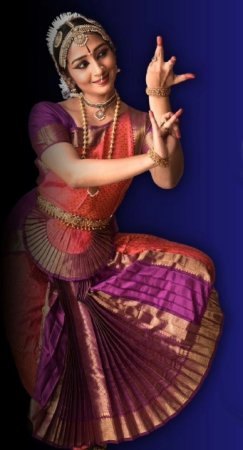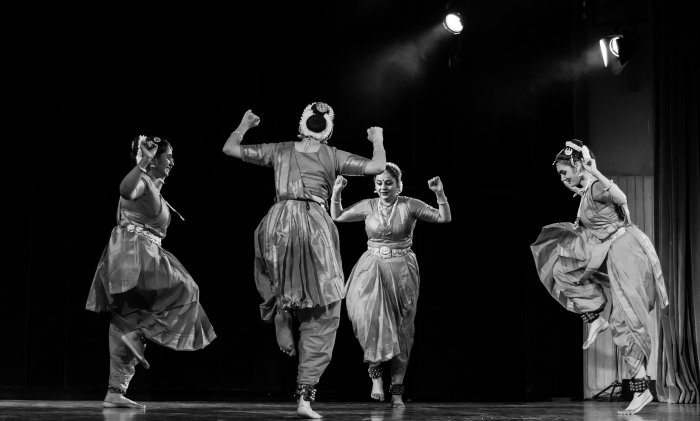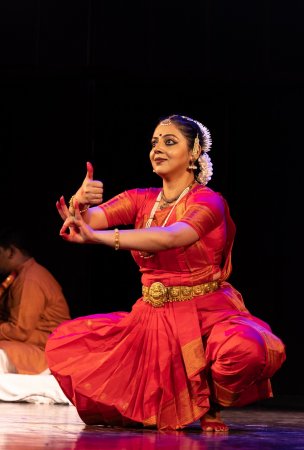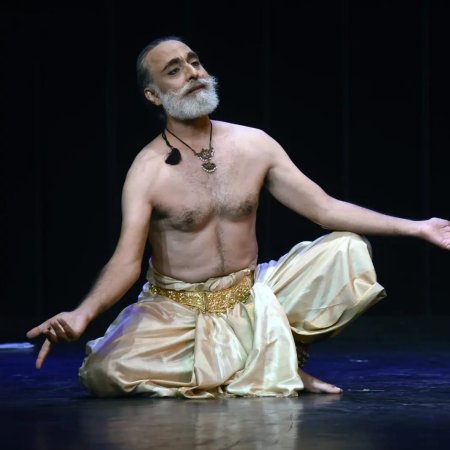
|   |

|   |
 e-mail: leelakaverivenkat@gmail.com Connection between poetics, music and abhinaya August 8, 2024 THREE-IN-ONE NEEDS MORE WORK It was called Sangam - saga in Devotion with three dance traditions Bharatanatyam, Odissi and Kuchipudi sharing the Stein auditorium stage at the Habitat - the concerned dancers, in the order of traditions mentioned above, being Ritwika Ghosh who apart from four years at Rabindra Bharti University has trained under Jayanti Subramaniam, Seetharama Sharma and Kalanidhi Narayanan; Rina Jana trained under Guru Kelucharan Mohapatra and 'Sanjunani' (Sanjukta Panigrahi); and Bobby Chakraborty who studied under Madhuri Mazumdar and off and on has trained under Vanashree Rao. One wonders if such evenings, prompted largely by the dancer verses opportunities-for-performance being so stilted, plus a feel that something different from the usual can attract more attention, are worth the effort involved. Looking at the pitifully slender audience seated in the auditorium, though a few more joined in later after the inauguration by the chief guest Vanashree Rao, the long winding introductions for each dancer had no place and should have been avoided. Ultimately what is shown on the stage as performance, is what audience mind carries home. The opening item in Sri ragam set to adi talam visualized divinity in the form of Krishna in different facets - as cherubic infant, as playful tormentor, as vanquisher of evil forces, and finally as the charioteer for Arjuna in the Kurukshetra war - symbolically holding the reins of fate of mankind and destroying evil and finally incarnating as man's rescuer through different manifestations of the Dashavatar. Ideas moved fast with the music and it seemed that in the simultaneity of different stylistic movements, no dance could blossom in a holistic expression. Following the stage entry made with each dancer in the typical gait of the dance form she represented, the rest of the group formations on stage, while accommodating three traditions, looked restrained and ill defined. Rina Jana in the centre was the most active, while Ritwika's Bharatanatyam with mincing steps, and a permanent smile, seemed cramped, with the Bharatanatyam profile, not finding any space for expression. The next Tarijham item Samvad, familiar terrain for Odissi dancers, in Brindavan Sarang raga, with its accent on nritta, was also found wanting. The Kuchipudi part with Bobby Chakraborty trying to emulate some of the footwork virtuosity of Kuchipudi, looked less constrained than the Bharatanatyam, with the central stylistic concern of araimandi totally unarticulated in any of the hesitant pure dance. Ultimately, it was in the solo projections, that the best in each dancer came out. In the Kasturi Tilakam in Mohanam with Narayana Teertha's Neela Megha Sareera exuberance with the Tarangam dancing on the rim of a brass plate, Bobby Chakraborty was relaxed. As virahotkhandita Nayika, Radha pining for Krishna in the ashtapdi Savirahe tavadeena in Misra Kafi, Rina Jana dilated on Radha's anguish where even the moon beams and the cool breeze seemed to sting like poison in the absence of Krishna. The best of the abhinaya, such as it was, came from Ritwika's projection in Bharatanatyam, as she donned the role of Radha as abhisarika in Swati Tirunal's Chaliye Kunjanamo, again in Brindavan Sarang. Her subtle mukhabhinaya with eye movements was most communicative - while trying to coax and seduce Krishna, that the time was right for an idyllic twosome. With the Neerabhari Jamuna in full flow, and the air full of the song of cooing birds, (Suniye Koyalik Boli Piya) and with her by his side, what better time than now, for retreating to the Kunj? Expressional dance is obviously Ritwika's forte. The finale was another ashtapadi, Chandana charchita neela kalebara peeta vasana vana mali in raga Brindavan Sarang, the raga which seemed to have held performance conceptualization in some kind of a trance. But somehow that intense communication with the dancers' inside speaking was totally missing. Different forms sharing the stage in a performance, call for a tremendous amount of homework in keeping the totality in mind while reconciling styles in a panoramic view which while synchronized, does not stifle self-expression of any form.  Ramya Suresh And it is precisely for crafting the program intelligently that one prized the performance by Ramya Suresh (also a doctor by profession who I recently covered in fair detail in this very column and will not review here) at the Habitat. Without Guru Indira Kadambi's (the latest amongst three gurus she has studied under) presence, and performing to recorded music, a whole recital was built round the 'sakhi' in sringar, starting with a recently created varnam in Amritavarshini, addressing the sakhi in an earnest appeal, the tone as imploring from start to the charanam finish, to this messenger of love to Venugopal, changing in the Padam Unnai Thoodanuppinen to the sakhi becoming the other woman, making use of the opportunity of calling on Venugopal, by indulging in moments of passionate dalliance with him herself - to once again being seen in the role of the earnest friend in the ashtapadi Pashyati Dishi Dishi Rahasi Bhavantam-Seedati Radha Vasa grihe where, in an impassioned appeal, the sakhi paints before Krishna the pitifully wasting away state of Radha, who in her unrequited love for him seemed to be losing her mental acumen. BHARATANATYAM ON TRADITIONAL ASPECTS OF THE MARGAM Yet another doctor practicing Homeopathy, Dr.Anjali Raju based in Pune, running Samarchana, a school for Bharatanatyam and Kuchipudi, presented an evening titled 'Traditional aspects of the Margam' (is not the Margam the traditional concert format?) featuring her and disciples in a solo/group blend at the Habitat. Inadvertent slips by the compere for the evening Uma Godke apart (as one providing the nattuvangam lead, she should not have been ignorant about details of a tala), Delhi's Vasudevan stepping in as vocal support contributed with a most evocative component combining technique with highly involved singing. Wing support, on the whole was fair, despite kalapramanam adjustments.  Anjali Raju and ensemble The group presentation fashioned round the idea of a temple event, started with the idea of a parikrama of the temple with the deity, with the Mallari in Gambheera Nattai followed by homage to Ganapati, Ananda Nartana Ganapatim Bhavaye danced by the group of disciples Surabhi Ganguly, Anuriya Lad, Jyotsna Rajamani, Tisya Palsokar - all with good technique and neatly crafted movements. The performance went on to the high point of the recital with the varnam in Bhairavi, Mohamana en meedu, a solo projection by Dr. Anjali herself. Technique, grammar, and movement elegance apart, the expressional thrust with lines addressed to the Lord by the Nayika, Modi Seyyalamo endan swamy (Why tarry, she asks, in answering her invitation) followed by the Nayika's complete offering of herself to 'Bhoga Tyagesa' (Anubhogam seyya va), - for this critic, fell short of conveying the overwhelming passion of sringar surrender. The next presentation comprising Periyaswamy Thooran's composition in raga Brindavan Saranga, Kaliyuga Varadan , in praise of Lord Muruga, was a well co-ordinated performance by disciple Amruta Nevgi, concluding with Kavadi chindu, portraying the devotee dancing with the weight bearing rod of the 'Kavadi' slung across the shoulders.  Amruta Nevgi The Padam in Saveri Ethanai Sonnalum presented by Dr.Anjali, projected the exasperated mother, berating the daughter on how many more times would she have to be told, to learn to get on with her husband - instead of displaying the typical female behavior of rushing over to the mother's house at the slightest provocation. The annoyance apart, it was the frustrated mother which needed more thrust in the interpretative part. Neatly rendered by the group, was the finale of a Tillana in raga Paras. That a person with a full time career in medicine like Dr.Anjali, should be pursuing this degree of serious involvement with a dance tradition, says a lot about her commitment to the art form. ABHINAYA AND POETICS OF ABSENCE Various unconnected events last week set me wondering about the connection between poetics, music and abhinaya. How does one describe sringar? Why is its expression so much more potent in the torment of its absence, than in the joy of its fulfillment? All creativity in art seems to wallow in the search for that unfulfilled state - a space which defies definition. Music and dance strive to evoke that space, in the process of pursuing it through the art form. It is not a static space one can measure or describe, but occupies a haunting presence in the mind - overwhelming in its urgency. Through chosen recorded bits of the most soulful music by the greatest of artistes past and present, representing myriad languages and musical / poetic genres, Bharatanatyam / Contemporary Dance / Yoga specialist Navtej Singh Johar, at the India International Centre Annexe on July 19, in a talk titled Poetics of Absence, touched on that enigma of what one understands as sringar. From T.M. Krishna's impassioned rendition of Muthuswamy Dikshitar's Kriti Jambu pathe maam pahi evoking Shiva, to Chisti Ghulam Sayeed's urgent cry that everything - intelligence, consciousness, tears, et al, in fact everything is You - spiritual devotion invests totally in that intoxicated search for that state of being, or space which defies definition. In all Padams, Javalis, Ghazals, it is that not legitimized space that the seeker cries out for. It is a state of being involving two unequal beings - beyond rationality, and it is perhaps this asymmetry that makes the desires of the devotee even more driven. It is, by its very nature, not what one recognizes as moral space. Kshetraiyya's works, in the book by westerners titled 'When God is the customer' ponders on this viraha and its torment, fuelling most of love poetry. And even if and when, one were to attain that space, it is only for a moment - for if permanent then there would be no more room for the 'lila' or play of that high powered emotion, crying out for that unity. When two becomes one with 'His' arrival, the excitement is over. Which is why, Radha, after becoming one with Krishna in Kuru yadunandana asks Krishna to erase the effects of the oneness, by giving her back her identity as Radha, for she wants the dualism without which that excruciating desire and search once again for the ecstasy of that union will cease to exist.  Navtej Johar Among the bits of poetry and music chosen by Navtej was mein Rovanti by the Punjabi poet. It is the chamatkar of that yearning so emotively caught in the bits of a Thumri in raga Todi, made so famous by Bade Ghulam Ali Khan, or in the torment of Rasoolan Bai's voice that holds the listener enthralled. Kshetragna's Ninnu Joochi in Punnagavarali describing what is seen of the loved one, in the dream during sleep, or what a Begum Akhtar or Attari Bai's singing brought out so evocatively, does not belong to the realm of tangible space. The singer, who can in the singing voice that potent lament, provokes and inspires the body of the dancer to respond. But proper abhinaya is not a word for word translation of the singer's rendition, but a non-textual elaboration of what the words suggest, emerging from manodharma or mindscape of the dancer - which is why great abhinaya is impromptu, depending on improvisation. The dancer can get inspired on one phrase like dil atkiyan (which Navtej referred to so forcefully) referring to having no control in getting embroiled in this love knot, he cannot free himself of. This one idea can lead to several gestural/expressional spin offs. SRINGAR TODAY In the present climate, music which provides the thrust, has acquired tremendous technical skill and virtuosity - but is that old quality of yearning missing? Great punditry, where it certainly exists, 'will not come down to the level' of being connected with dance. With dance training open to all, that deep awareness of the throb of poetry in the language of the dance tradition, is less. And the rehearsed arrangements of gesture and expression for each line of the song (set with great care and understanding no doubt) have made improvisation rare. How many Lakshmi Viswanathans does one find among young Bharatanatyam performers? In the historical convulsions of the post hereditary / devadasi / temple / royal mehfil period, with dance being repositioned for proscenium spaces, and its doors thrown open to all seekers, there has been a lot of, often acrimonious, discussion/exchange on the nature of sringar - regarding the chasm between Sringar Bhakti and Bhakti Sringar, and about technical virtuosity losing sight of the emotional throb of sringar. But that is a whole different topic in itself.  Writing on the dance scene for the last forty years, Leela Venkataraman's incisive comments on performances of all dance forms, participation in dance discussions both in India and abroad, and as a regular contributor to Hindu Friday Review, journals like Sruti and Nartanam, makes her voice respected for its balanced critiquing. She is the author of several books like Indian Classical dance: Tradition in Transition, Classical Dance in India and Indian Classical dance: The Renaissance and Beyond. Post your comments Pl provide your name and email id along with your comment. All appropriate comments posted with name and email id in the blog will also be featured in the site. |